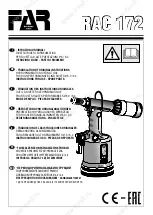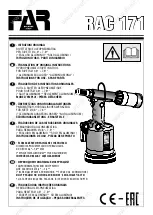
6
6. Grip the tool as lightly as possible (while still maintaining a secure hold). Let the tool do the
work.
7. To reduce vibration, maintain tool as explained in this manual. If abnormal vibration occurs,
stop immediately.
SPECIFICATIONS
Blow per minute: 4500bpm
Max operating pressure: 6.2bar
Avg. air consumption: 5cfm
Air inlet :1/4"
Stroke length: 1-5/8"
Bore diameter: 11mm
Net weight(without accessories):1.1kg
INITIAL SETUP & ASSEMBLY
Air Supply
WARNING: To prevent serious injury from explosion, use only clean, dry, regulated,
compressed air to power this tool. Do not use oxygen, carbon dioxide, combustible gases, or
any other bottled gas as a power source for this tool.
1. Incorporate a filter, regulator with pressure gauge, oiler, in-line shutoff valve, and
quick coupler for best service. Refer to the diagram at the end of this manual for more
information. An in-line shut-off ball valve is an important safety device because it
controls the air supply even if the air hose is ruptured. The shut-off valve should be a
ball valve because it can be closed quickly.
Note:
if an automatic oiler system is not used, add a few drops of pneumatic tool oil to the
airline connection before operation. Add a few more drops after each hour of continual use.
2. Attach an air hose to the compressor’s air outlet. Connect the air hose to the air inlet of the
tool. Other components, such as a coupler plug and quick coupler, will make operation more
efficient, but are not required.
WARNING:
To prevent serious injury from accidental operation, do not install a female quick
coupler on the tool. Such a coupler contains an air valve that will allow the air tool to retain
pressure and operate accidentally after the air supply is disconnected.
Note:
Air flow, and therefore tool performance, can be hindered by undersized air supply
components. The air hose must be long enough to reach the work area with enough extra
length to allow free movement while working.
3. Release the tool’s trigger.
4. Close the in-line shut-off valve between the compressor and the tool.
5. Turn on the air compressor according to the manufacturer’s directions and allow it to build up
pressure until it cycles off.






























